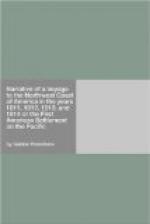We found no good water near Karaka-koua bay: what the natives brought us in gourds was brackish. We were also in great want of fresh meat, but could not obtain it: the king of these islands having expressly forbidden his subjects to supply any to the vessels which touched there. One of the chiefs sent a canoe to Tohehigh bay, to get from the governor of the island, who resided there, permission to sell us some pigs. The messengers returned the next day, and brought us a letter, in which the governor ordered us to proceed without delay to the isle of Wahoo, where the king lives; assuring us that we should there find good water and everything else we needed.
We got under way on the 16th and with a light wind coasted the island as far as Tohehigh bay. The wind then dropping away entirely, the captain, accompanied by Messrs. M’Kay and M’Dougall, went ashore, to pay a visit to the governor aforesaid. He was not a native, but a Scotchman named John Young, who came hither some years after the death of Captain Cook. This man had married a native woman, and had so gained the friendship and confidence of the king, as to be raised to the rank of chief and after the conquest of Wahoo by King Tamehameha, was made governor of Owhyhee (Hawaii) the most considerable of the Sandwich Islands, both by its extent and population. His excellency explained to our gentlemen the reason why the king had interdicted the trade in hogs to the inhabitants of all the islands: this reason being that his majesty wished to reserve to himself the monopoly of that branch of commerce, for the augmentation of his royal revenue by its exclusive profits. The governor also informed them that no rain had fallen on the south part of Hawaii for three years; which explained why we found so little fresh water: he added that the north part of the island was more fertile than the south, where we were: but that there was no good anchorage: that part of the coast being defended by sunken rocks which form heavy breakers. In fine, the governor dismissed our gentlemen with a present of four fine fat hogs; and we, in return, sent him some tea, coffee, and chocolate, and a keg of Madeira wine.
The night was nearly a perfect calm, and on the 17th we found ourselves abreast of Mona-Wororayea a snow-capped mountain, like Mona-Roah, but which appeared to me less lofty than the latter. A number of islanders came to visit us as before, with some objects of curiosity, and some small fresh fish. The wind rising on the 18th, we soon passed the western extremity of Hawaii, and sailed by Mowhee and Tahooraha, two more islands of this group, and said to be, like the rest, thickly inhabited. The first presents a highly picturesque aspect, being composed of hills rising in the shape of a sugar loaf and completely covered with cocoa-nut and bread-fruit trees.
At last, on the 21st, we approached Wahoo, and came to anchor opposite the bay of Ohetity, outside the bar, at a distance of some two miles from the land.




